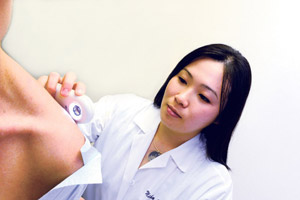Sun Protection Year-round
Dr. Mika Yamazaki,Dermatologist at Straub Clinic & Hospital
Where did you receive your schooling and training?
I received my medical training at the John A. Burns School of Medicine at the University of Hawaii and did my internship at UC-Davis. I then completed my residency in dermatology at the University of Texas Medical Branch.
How long have you been practicing?
I’ve been practicing at Straub for a little over one year.
Is some sun good for you or is it best to avoid it altogether?
I recommend that patients try to avoid sun exposure as much as possible. Sun protection is very important, especially here in Hawaii, and UV exposure is one risk factor of skin cancer that we can actually prevent.
More recently people have become worried about having low levels of vitamin D (from lack of sun exposure), but as dermatologists, we recommend that people get an adequate amount of vitamin D from their diet or from oral supplements, rather than using the sun.
When are the safest times of the day to engage in outdoor activities?
People should try to avoid the sun’s rays when they are at their strongest – between 10 a.m. and 2 p.m. Even if you’re going to be outdoors earlier or later than that, you should still be using sun protection.
Is there a sunblock brand or SPF level that is particularly recommended?
The main thing is to find a product that one will actually use. I recommend that people wear a broad spectrum sunscreen that has SPF 30 or higher and is water resistant. Broad spectrum means that it covers for both UVA and UVB rays, and this should be specified on the packaging.
When people come to you with sun damage, where are the most common areas?
The face, neck, ears, chest, upper back, arms and legs are usually the most affected. The lower lip also tends to have a lot of sun damage, as does the scalp in men with thinning hair.

Dr. Mika Yamazaki examines a patient’s skin for sun damage. Nathalie Walker photo nwalker@midweek.com
Definitely use sun protection measures such as sunscreen, lip balms or lipsticks with SPF, and sun protective clothing such as long-sleeved shirts, pants, hats with large brims and sunglasses.
Such measures should be taken whenever going outdoors, even if it is cloudy outside. Try to find shade whenever possible, and remember to reapply sunscreen about every two hours and after sweating or swimming. Most people only apply about 25 percent to 50 percent of the recommended amount, so apply the sunscreens generously.
Also, avoid using tanning beds, as these have been shown to increase the risk of skin cancers. If being tan is of concern, consider using a self-tanning product instead.
Is the sun more damaging to the skin in some geographical locations than others?
Yes. There is something called the UV index, which is a measurement of the strength of UV radiation from the sun.
As you get closer to the equator, UV levels tend to remain high year-round. Hawaii does tend to have a high UV index, so it is especially important to protect yourself from the sun.
Anything else you’d like to mention?
For people who work outdoors or spend a lot of time doing outdoor activities, it’s a good idea to see a dermatologist for yearly skin checks. Any lesion that is changing in size or color, bleeds, hurts or doesn’t heal after two to three weeks should be checked.




